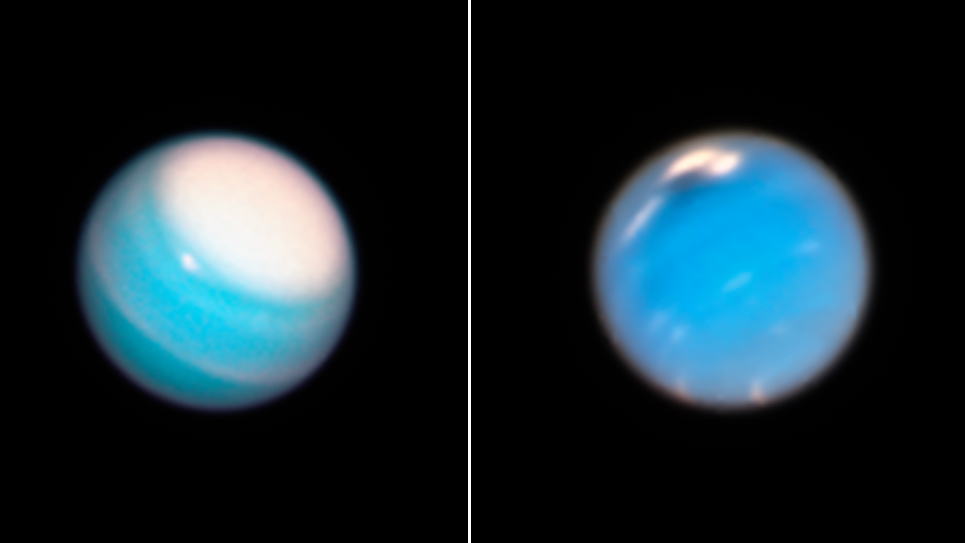3 Hidden Worlds Have Emerged From the Shadows of Neptune and Uranus

Scientists from the Carnegie Institution for Science, in partnership with observatories around the world, have discovered three new moons in the outer Solar System—one orbiting Uranus and two orbiting Neptune.
These moons are particularly tiny, with the largest of the three moons measuring only 15 miles across.
These moons were discovered (in some cases) over the course of a few years, and required a special imaging method in order to separate them from the stellar background.
We like moons, so any day our Solar System gets some new additions is a good one. Of course, these “new” moons are sort of like buying a used 2005 Buick LeSabre: definitely not sporting a new car smell, but hey—it’s new to us.
The three new moons—one orbiting Uranus and the other two orbiting Neptune—were spotted by researchers at the Carnegie Institution for Science. This puts the outer planets’ moon counts at 28 and 16 respectively. Discovery of these far flung bodies is a nice change of pace, as the Solar System’s largest planets, Saturn and Jupiter, have dominated the moon race as of late. Because Uranus and Neptune are farther afield than their gas giant cousins, they’re harder to image (and much harder to visit). As a result, small, moon-sized objects can fall through the cracks… at least, temporarily.
“The three newly discovered moons are the faintest ever found around these two ice giant planets using ground-based telescopes,” Carnegie Science’s Scott Sheppard said in a press statement. “It took special image processing to reveal such faint objects.”
The new addition to the Uranus collection, the first is 20 years, is S/2023 U1. This won’t be its permanent name as, like other moons orbiting the planet, it’ll eventually get a moniker borrowed from the works of William Shakespeare (might we suggest Tybalt?). The moon was originally spotted by Sheppard on November 4, 2023 using the Magellan telescopes at the Las Campanas Observatory in Chile. The moon is particularly small—only five miles across, which makes it the smallest of Uranus’ moons—and it takes 680 days to orbit the planet.
The other two Neptunian moons come in two flavors—bright and faint. The bright one, currently known as S/2002 N5, is 15 miles across and takes 9 years to orbit Neptune. The fainter one, S/2021 N1, is 9.3 miles across, orbits every 27 years, and was a bit tougher to discern. The European Southern Observatory’s Very Large Telescope and Gemini Observatory’s 8-meter telescope both needed ultra-pristine nights in order to clock the tiny satellite’s orbit. Both of these moons were originally spotted back in September of 2021 and confirmed with subsequent sightings in the following years using the Magellan telescopes. Both of Neptune’s newest additions will be named after the 50 Nereid sea goddesses in Greek mythology.
In order to view deeper images around Uranus and Neptune than ever before, astronomers used five-minute exposures over the course of three to four-hour periods across several nights. Shifted by the planets’ motion, this technique delivered more detail than any previous exposure near the ice giants.

“Because the moons move in just a few minutes relative to the background stars and galaxies, single long exposures are not ideal for capturing deep images of moving objects,” Sheppard said in a press statement. “By layering these multiple exposures together, stars and galaxies appear with trails behind them, and objects in motion similar to the host planet will be seen as point sources, bringing the moons out from behind the background noise in the images.”
These three moons’ orbits suggest that, while a new discovery for us humans, they have likely been orbiting around these icy planets since not long after their formation in the Solar System’s early days. Understanding these orbital characteristics could help astronomers piece together how these distant planets captured their satellites.
These new discoveries likely complete Uranus and Neptune’s moon list down to sizes of between 5 and 8 miles across. But Jupiter and Saturn’s lists extend to even smaller satellites. In other words, the search isn’t over.
You Might Also Like


